It was nice to sleep in this morning, our tour was not scheduled to start until 9:15 AM, and that gave us more time to rest. We are sleeping well, but the altitude definitely affects our sleeping. Stephanie has been using the oxygen concentration a little just at night, her oxygen levels are a bit lower than mine, hers are in the upper 80’s. She is just using the supplemental oxygen from the concentrator on the lowest setting, 1 liter per minute, for a short time when she first goes to sleep, taking it off a couple of hours.
We set an alarm for 7:30 AM giving us enough time to get ready and go to the buffet breakfast without rushing. Also, we did not want to eat right before we left because it is just a short ride to the Potala Palace, and we did not want to be too full before the long climb on the steps up to the palace.

Stephanie wandered around our floor for a bit after breakfast as I desperately tried to catch up on the blog. She came back after a while and said there was an Oxygen Lounge on our floor, not far from the elevators. We had seen the hallway but had not seen any signs for what was down that way. The Oxygen Lounge was open 24 hours and she said there were some people sleeping in there. There were normal padded chairs and then some really nice lounge chairs. The oxygen level was posted to be 50% higher than the normal oxygen here outside in Lhasa at 12,000 feet in elevation. As an approximation, that would be similar to the oxygen level on an airplane flight.
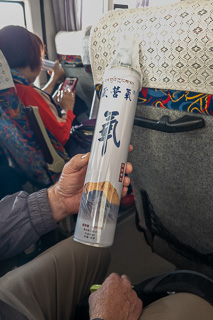
We headed up to the lobby at 9:10 AM to meet up with our guide Michael and the rest of the group. We found out that one of the two ladies traveling together had had some issues with the altitude and had to go to see the hotel doctor. Each hotel here, at least the higher level ones, has a doctor on staff and a medical area, which was also on our floor. They were not coming with the group this morning, which made sense, this will be a difficult day with a lot of climbing at the high altitude.
Once we got on our bus, each couple was given a canister of supplemental oxygen to share. It was larger than a spray paint can, about twice the size, and had a removable plastic face piece that fits over the bottom of your nose and mouth, and you just pushed down on the top and oxygen would flow out. It was really light, so I don’t know how much oxygen there was in it. Since we had to climb the 360 or so steps up to the palace this morning, this was in case we needed supplemental oxygen during the climb. We did not take the plastic off of the oxygen can in case we did not need to use it, we could turn it back in. Also, it kept the removeable face piece from dropping off accidentally.

We arrived at the bus parking area for the Potala Palace and had to walk a few blocks to the Palace entrance. There was a Security Station at the entrance and we had to scan our bags and show our passports, which were our entry tickets. Our passport numbers were already entered into the system for verification that we had paid.
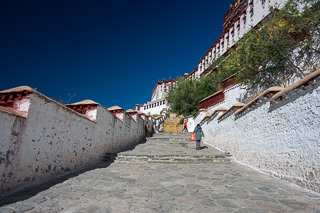
Once through security, we used the restrooms and then headed over to an area where we could take a great picture of the palace high up on the hill. Some of our now reduced group of 20 were not going to attempt the climb at all due to physical limitations. I had been worried about my hip bursitis, so I had taken one of my prescribed pills, Meloxicam, to help reduce the inflammation and therefore the pain, so I was ready to go.
We were also given the option to just climb up to the entrance, or anywhere in between, and then head back down if we could not go farther, The only limitation was that once we entered the palace itself, it was only one way through to the exit and there was no turning back. Of course, there were still steps to climb inside the palace once we got that far, we were told we had to go up about 5 more stories once we were inside.
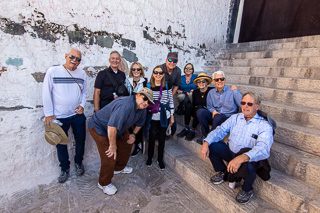
The stone walkway and steps up to the palace entrance were not that high or steep at first. In total, there were about 4-5 switchbacks to get to the top. As we climbed, some of the steps were not that uniform, but not terrible. There were also sections of areas where it was just sloped upward without steps. At each switchback, we stopped to rest and catch our breath. We did not use the oxygen tank at all, and never even thought to do so even though we were certainly breathing hard in the thin air. In retrospect, we should have tried it out just to see what effect it had, but it was almost like a badge of courage not to use it.
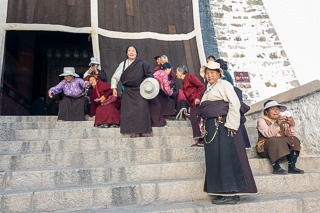
Ten of us made it all the way up to the entrance. We were not sure how many people in the group actually started up and how many people had turned back during the climb. Of course, there were many Tibetan people at the top including a group oof older ladies, and that made us feel like we were a little unfit, which we are at 12,000 feet in altitude!.
Once we were at the entrance, our guide gave us an audio device. We were not allowed to use the one issued by Viking, we had to use the ones issued by the palace itself. We were told this same thing at the temple yesterday and were told that it was so “security” could monitor what was being said by the guide. This is apparently due to the political issues between Tibet and China which we will cover in a separate post.

From this point forward on the tour, it was all or nothing, there was no turning back once we entered this large gate. Everyone would have to go through and make it to the exit.
We headed inside the main entrance and after ascending more steps, this eventually led to a large courtyard. We were able to take photos in the courtyard, but once we entered the next area of the palace, photos were not allowed. We took a few photos of our group in the courtyard, we were all trying to catch our breath after all of the climbing to get to this point.
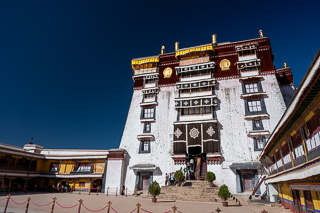
We headed into the palace entrance for the upper section of our tour. The Palace was interesting. On the top floor was where the Dali Lama would stay if he were still in Tibet. He has been in India for quite a number of years, the Chinese Government took over Tibet during that time, and the Dalai Lama was forced to escape to India, and is in exile there. He was both a religious figure and head of the government before China took over Tibet. For most Chinese and Tibetans, it seemed like they are now better off under the Chinese government
The Chinese government is spending a lot of money to improve living conditions in Tibet. According to our guide Michael, there was a strict class system under the Dalai Lama, and many people were suppressed by that government because of that caste system. Now people are treated more equally and have the opportunity to improve their lives. Like several other things we were exposed to, we will need to do some research to try and understand what the real situation in Tibet is.
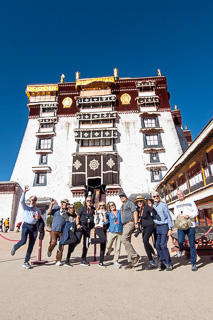
In other areas of China, the government and the religious leaders were separated and the people were not under religious governance. But in Tibet, it had always been different with the Dalai Lama. He is still considered the most important religious leader in Tibet, and they firmly believe that each Dalai Lama is a reincarnated version of the previous one. This is at least our very basic understanding of the culture and religion.
There are also different Buddhist beliefs in Tibet from the other parts of China, they are similar in their worship of the various forms of Buddha, but are much more religious in their everyday lives, or so it seems.
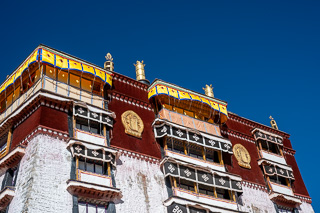
There were some very steep wooden steps inside the Palace we had to climb to get to the top floor. The top floor of the Palace was the location of the Dalai Lama’s residence and bedroom. There was an area for meeting dignitaries, and this floor was set aside specifically for the interests of the Dalai Lama’s everyday duties. That was why there were yellow curtains on the windows, this yellow is the color of the particular sect of monks of the Dalai Lama.
We also learned a lot about how the Dalai Lama is selected once the reigning one dies, it was very interesting and we hope to explain that in a separate post we will add later on.
We exited the portion of the palace used for governmental offices and then entered the portion used for religious purposes. The religious portion of the palace was painted in a crimson color to designate it as the religious section, and the part used for governmental use, which is much larger, was painted in a whitewash. Our guide told us that the whitewash is redone every year closer to the time of the Chinese New Year, which varies from year to year since it is based on a lunar calendar. The whitewash is basically made from local minerals, as is the red that is painted on the other portion of the palace. Potala Palace is considered to be the Winter Palace for the Dalai Lama.
We were not allowed to take any pictures in these areas of the palace. Once we entered, it was a “No Photo” zone, mainly for respect of the religion and religious items inside.
We do know that all of the wooden steps inside were that steep, it was a cross between steps and a ladder, each floor had one set of steps to get to the next level, and the steps were wooden and really steep and each step was not very wide in depth. With my much larger than Chinese feet, I had to take each step one at a time going down, I had to have my feet sideways on the step surface for my foot to even come close to fitting.
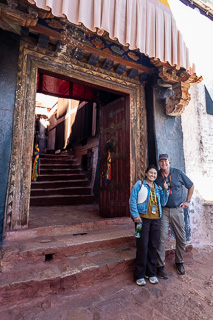
In one area, we saw two of the three stupas that are here in the palace. Stupas are the burial method for highly religious persons, and especially for all of the Dalia Lamas. They are large structures, similar in shape to a flat pagoda, and on the top is a glassed area where the body is put. The body is not embalmed or mummified like the Egyptians did, but it is preserved by using salts and other herbs. We could not see anything in the top portion because the lighting was so low, so I was difficult to know if the body was lying in that part we could see or not.
We were on a time limit for the inside portion of the palace we were visiting, we had only one hour to transit from the start to the end, which was a one-way path. Our local guide had to actually scan a code at the beginning and end to make sure it was done within the hour time limit, and I asked her what happened if that time limit was exceeded. She said that her privileges to conduct tours here would be suspended for a week if the time was exceeded. It is strictly done in order to keep everyone moving in the tight and cramped areas we visited. If people lingered, it would back up all of the subsequent tour groups. Luckily, it was not crowded today, it was right after the recently ended national holiday week, so there were much fewer crowds, everyone was now back at work.
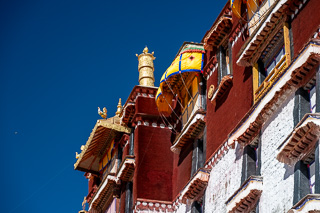
It was now time to head down to the bottom of the palace grounds, and the pathway down was separate from the pathway up. It was similar, there were several switchbacks, but one difference was that the stones were much more irregular, and not as flat as the pathway up had been, making it harder to walk down. It was easier from a breathing perspective, but not from a footing perspective.
Once everyone in our smaller group reached the bottom, we met back with the rest of the group that had not taken the steps up to the palace due to physical walking limitations. Michael had stayed with that group and they had visited a local park where some local Tibetan dancing was taking place.
We all walked back to the street to wait for our bus to arrive to pick us up. It was a busy street and it took about 15 minutes for the bus to arrive. In the meantime, several ladies approached and were selling different kinds of necklaces and bracelets and they were pretty aggressive. Some of the items looked nice, and several people in our group bought items, which attracted even more sellers. A few minutes later, a policeman walked up and chased the women off, but they returned after he walked away.
Our bus arrived and we got on. We were taken to a local restaurant to eat lunch, which was pretty good. It was a buffet, and we sampled several of the items. Once again, some items were good and others were just different, but we certainly had plenty to eat. We were there for an hour eating, and then we took our bus back to the hotel, arriving at about 1:30 PM.
We were scheduled for another tour at 3:00 PM, we are visiting the Sera Monastery.
We headed back to the room but stopped off at the Oxygen Lounge, which Stephane had seen but I had not yet gone to. It was really nice inside, and one area was heated and one area was cooled with air conditioning. It had really comfortable chairs in both of these areas.
We headed back to the room and rested, I tried to work on the blog posts from several days ago to catch up while Stephanie rested.
We headed back to the lobby to go on the 3:00 PM tour to the Monastery. Several people in our group had decided not to go. We had been told this morning that the walk to the monastery was about thirty minutes up a gradual hill to the top, and I have to say that our legs were sore from all of the steps this morning, but not enough to not go on the tour. The special attraction at the monastery is that they do debating in the afternoons from 3:00 to 5:00 PM. This is one of the few monasteries that allows tourists to visit during their debates, and this is done as way to attract people to visit since it is about a 25-minute drive from Lhasa. Of course, there is an entry fee for the Monastery, so it is a way to generate income. Daily debating is part of all monasteries’ religious learnings, but none of the others allows tourists to watch them.
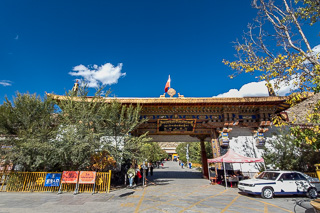
We drove to the monastery and the bus dropped us off a few blocks from the entrance. The entrance to the monastery grounds was at the bottom of the hill, and once inside, we had the described 30-minute walk up to the top of the hill to the area where the debates occur. There are only about 500 monks here now, but in the past, there were as many as 2,500. There is not as much interest or tradition in becoming a monk, many of the men who joined in the past were part of large families, and if there were several children, often one or two of the younger male children joined the monastery to become monks In that period of time. it was a honorable thing for families to do. In the days of the single-child regulations in the 1980’s, there were no longer any large families, and with a single male child to carry on the family name, not many men joined the monastery.
It was not a difficult walk, there were no steps, just a stone street. Some areas were smoother than others, so you had to watch your step. Apparently, one of the other Viking groups that was here this morning had someone fall on this walk due to the irregular surfaces. Along the roadway were the residence buildings for the monks. There were at least two levels, and the ground level had windows that were about at street level. The upstairs bedrooms were nicer, and our guide told us that this was where most of the monks lived since the population was so low now. No one needed to stay in the lower and less desirable rooms.
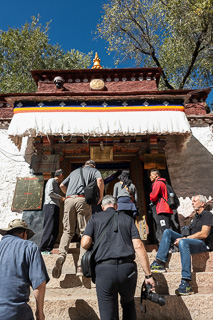
Once we made it to the top of the hill, we went up some steps into a large courtyard covered with a fabric tent-style roof. There was a walkway around the open area, and this was for us to be able to walk around the courtyard while the monks were debating. There were about 100 monks or more here, in small groups. Within each group, there was one monk standing and addressing another sitting monk. According to the explanation we got from our local guide, the standing monks were asking questions of the sitting monks, who would then respond to the question. If the answer was correct, the standing monk would make a large clapping gesture, one arm would make a large circle and slap the corresponding other hand.
We were not sure if the debate was for training to see if the monks understood the teachings they were being asked questions about, or if the “debate” was more philosophical in nature, asking questions about philosophical interpretations. Our local guide told us she understood what they were saying since it was in the Tibetan language, which is different from Chinese, but she was not able to comprehend what they meant since it was discussing the philosophy of the Buddhist religion and it was not something she was able to comprehend.
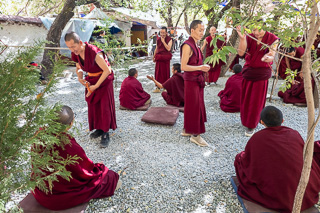
It was interesting, but of course, we had no idea what anything was about, we were mainly watching the debate as a show, not something we could understand or ponder.
After our time was up to watch the debating, we all headed down the path toward the Assembly Building and headed inside. This is where the monks gather for different things, and one thing done here is to read some of the written parchments that are contained in hundreds of boxes on one side of the assembly area.
There were also several different Buddhas inside, as well as some other wooden carvings that were the protectors of Buddha. There were several metal bowls of water, which were placed here every day for blessings and then used by the monks. In addition, we saw several shelves of small Buddha statues in colorful dress, and I think our guide said they were brought here by ordinary people to be blessed in some way before they were taken to their homes.

Inside, we also saw large urns filled with Yak Butter and these had several wicks inside of them to burn as candles, apparently, the Yak butter is less smoky than the bees wax to burn for candles.
Outside and next to the assembly building was a large kitchen. This kitchen is only used when there are large assemblies of monks, and these assemblies occur at least four times per month on certain numbered days of the month. These months are based on a lunar calendar and not the traditional Gregorian calendar used in most places worldwide. Otherwise, the monks cook in their individual rooms. Our guide has two twin cousins here at the monastery, and one works in the kitchen, but no one was in the kitchen when we went through it.
 Outside in an area by the assembly Building was a structure in a small courtyard. This contained many large Prayer Wheels. These are spun by people as they walk by them, and it symbolizes that you have recited the prayers that are attached to the inside of the spinning cylinder. These were made because many people in Tibet could not read or understand the prayers, so it afforded them a method of saying the prayers by spinning the wheel. These are found in many area around Tibet, especially in holy places like temples and monasteries, and there are also hand held sizes that we saw many people carrying and spinning them back and forth in their hand, all for the same purpose, saying prayers.
Outside in an area by the assembly Building was a structure in a small courtyard. This contained many large Prayer Wheels. These are spun by people as they walk by them, and it symbolizes that you have recited the prayers that are attached to the inside of the spinning cylinder. These were made because many people in Tibet could not read or understand the prayers, so it afforded them a method of saying the prayers by spinning the wheel. These are found in many area around Tibet, especially in holy places like temples and monasteries, and there are also hand held sizes that we saw many people carrying and spinning them back and forth in their hand, all for the same purpose, saying prayers.
We all started our walk back down to the bottom of the hill and stopped off at a bathroom. There was a metal folding partition that was partially closed in the entrance, but our guide stopped us and asked if anyone needed to use the restroom. I did and so did another person in our group, a lady. There was a man mopping the floor at the entrance to both restrooms and I had to get around him, and I thought he grunted something. As I was using the men’s room, which was just a large trough for a urinal and small individual troughs for the squatting potties, I heard our guide say something, and apparently, the man was trying to close the gate, but the two of us were still inside, so our guide had to stop him, which was a little funny. No one outside had really been paying attention to the gate closing at first until our guide realized no everyone was back outside yet. Apparently, the bathroom was supposed to be closed by this time, who knew?
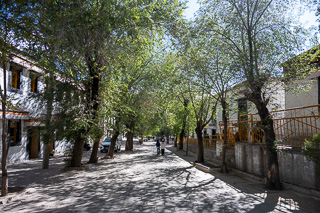
We headed back down to the entrance, and stopped at a golden-colored statue of an elephant with a monkey riding on its back. The monkey was holding a rabbit above its head and there was a bird sitting on the back of the rabbit. It was next to a fruit tree and represented the animals based on a Tibetan story called the “four harmonious friends” also known as the “four harmonious animals”. It is based on a story derived from the Jataka Tales of the Buddha, and in short, the bird plants a seed, the rabbit waters it, the monkey fertilizes it, and the elephant agrees to protect it. The seed grows into a bountiful tree, and through camaraderie and teamwork, the four friends figure out a way to reach the fruit.
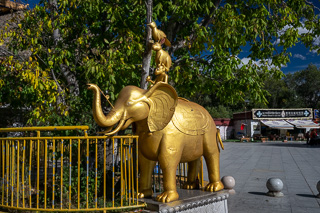
From here, we walked several blocks to an area where our bus could pick us up, and then we drove about 30 minutes back to the hotel. On the ride back, our guide explained the four different methods that are used for burials when people die. No one is typically buried in the ground in Tibet. There are generally four types of burials, the first and most common is the sky burial, then the water burial, then cremation, and the last is reserved only for the highest levels of the religious orders, the stupa burial, which we had seen this morning in the palace we visited.
There is a “undertaker man” as described by our guide, and he is responsible for disposing of the body depending on the type of burial. Since cremation is understood, and the stupa is sort of a preserved body method, we will only briefly describe the other two, which are a little bit odd.
This information started because of a discussion about what types of meat the Tibetan people eat, and they do not eat any fish. The reason is that the water burial happens when the undertaker man gets the dead body and basically cuts it up into small pieces and then dumps it all into one of the large rivers, and then the fish eat the body, which is why they don’t eat fish here, not because of anything other than a religious belief that the fish contains the body of the dead from eating it, it is not based on medical reasons.
Now, a little information we were told about the even stranger sky burial. The undertaker man does the same thing as with the water burial, the body is cut up into pieces and placed at one of two places made especially for the sky burial. These are chosen because they are areas where vultures habitat. The vultures eat the flesh of the bodies, and since the bones are usually cremated. They alternate between the two Sky burial sites so the vultures do not get overwhelmed with too many bodies at each site. In general, people are not allowed to go to these burial sites, and especially not women, for some reason.
Sky burials are not used for anyone who takes a lot of medicines or was poisoned, they have to be cremated because the vultures will not eat their flesh. If the vultures do not eat the flesh rapidly, it is supposed to have some negative religious significance, something like the person was not holy in their life here. Of course, all Buddhists believe in reincarnation, so they do not have any issues with what we might consider to be improper treatment of a body for these types of burials since they believe the spirit has already left the body gone to its next life, which is why they wait one day after death before any of the burial methods take place to make sure the spirit has found its next life.
It was all interesting to hear, if not a bit gory.
We arrived back at the hotel at around 5:15 PM and had the rest of the evening to ourselves. We were eating dinner in the hotel buffet and it is not bad, but typical for these buffets, lots of food items that we don’t know about, or items we try not to eat like some of the seafood, especially oysters and scallops. We were able to have some wine with dinner tonight having been too worried about drinking alcohol at the high altitude on the first two nights here. Now were were more acclimated.
After dinner, we headed back to the room to repack our suitcases. Tonight is our last night in Lhasa and we will be leaving early tomorrow morning at 7:15 AM to drive to the airport to fly to Xi’an, home of the terra cotta warriors. We realized we had brought too many thick clothes to wear in colder weather thinking we would need them here in Lhasa, but the temperatures here were not that cold, and the air is dry, so it never felt cold, and we never needed the heavier clothing we brought. We now knew we could pack these unused clothes in the bottom of our suitcases, no longer having a need for them, along with our dirty clothes. We are trying to keep them separate from our remaining clean clothes. Luckily, we do not have to put our luggage outside our door until 6:00 AM tomorrow morning.
It will be nice to get to a lower altitude, although, by tonight, we felt we were fairly well acclimated. We headed to bed at about 10:30 PM after setting an alarm for 5:50 AM tomorrow to put the luggage out by 6:00 AM.
Leave a Reply